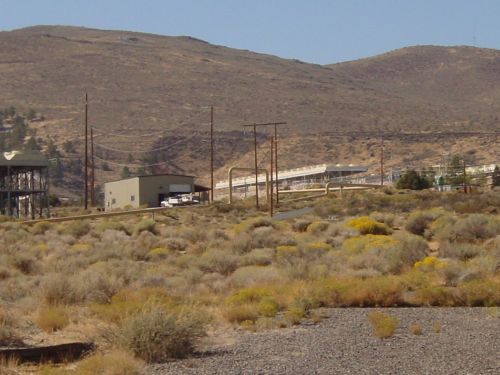Archive for October, 2007
Galloping Gertie Wind Harvest
Using aeroelastic flutter, the same effect that resulted in the collapse of the Tacoma Narrows Bridge (aka Galloping Gertie), Shawn Frayne has created a wind harvest device that is small, cheap to produce, and simple. The 2:05 video below has details of the breakthrough.
Tip of the Hat: Popular Mechanics 2 comments
Another Conservation Game
This time, from Chevron. In July we wrote about My Abodo, a consumer-focused exercise that enabled one to make choices about how they live then to see the impact of those changes on the environment around them. In retrospect, it was a very cool exercise and you can still see our little MeV home we created – optimized for lowest level of impact.
Today, Chevron has gotten into the act with WillYouJoinUs.com, more a Sim City approach to the same problem where you, the Mayor and CFO make decisions about energy supply then watch the impacts on economics, environment, and security through a few simulation phases over time. A screen shot of MeV City is located below the jump.
It’s great to see Chevron get engaged in this area, their bread is obviously still buttered by fossil fuels, but in the last few months they seem to be getting on the green bandwagon. Would it surprise you to learn that Chevron is the world’s largest geothermal electricity provider? Interesting, I’d think that geothermal power would be an option on their game. Oh well…
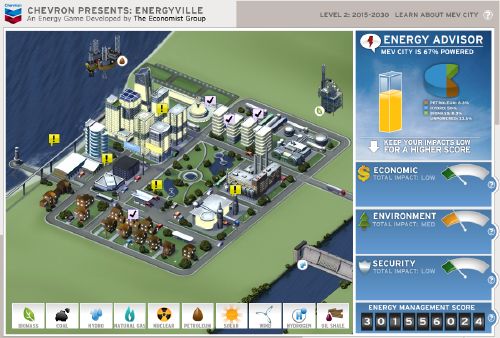
Tip of the hat: Didn’t You Hear? Comments are off for this post
DoE: 30 years and $350B later
This month marks the 30th birthday of the US Department of Energy. Formed in the aftermath of the 1970’s energy crisis, the Department was created to catalyze the transformation of the US from a net-oil importer and net-pollution exporter into a nation with a secure energy supply and sustainable environmental footprint while keeping the economy humming along and keeping energy prices stable for consumers. The 2007 version of the Department’s mission is:
- Energy Security
- Nuclear Security
- Scientific Discovery and Research
- Environmental Responsibility
- Management Excellence
While it’s clear there have been many accomplishments that the DoE can claim, relative to their mission, these are the results of the 30 year history:
- Energy Security – 1977, 77% of our electricty generated from fossil fuels and 46.5% of oil imported. 2007, 70% of our electricity generated from fossil fuels and 65.9% of oil imported.
- Nuclear Security – 1977, The US, USSR, UK, France, and China were nuclear powers. In 2007, India, Pakistan, Israel, North Korea, and perhaps Iran have entered the fraternity. Security has proven lax at national labratories and military bases. Nuclear electric power production has increased from 9% in 1977 to nearly 21% in 2007. Nuclear waste management issues are still unresolved and the problem continues to grow. There have been no nuclear attacks.
- Scientific Discovery and Research – Many interesting discoveries have been made; but the percentage of fossil fuel electricity generation, the nuclear waste issues, and oil import growth indicate that the breakthroughs are not making it to commercial application at a fast enough rate to make a difference.
- Environmental Responsibility – Renewable electrcity production has decreased in share from 14.3% in 1977 to 9% in 2007. CO2 levels have grown from ~335 parts per million in 1977 to >380 ppm at present.
- Management Excellence – Though it’s not quite clear what this means, the budget of the DoE was $6.3B in 1977 and has grown to $23.5B in 2007. The cumulative spend on the DoE from 1977 to present is estimated to be in excess of $350B.
Many dedicated and talented people work for the DoE, we’ve met them in our travels. However, we have to question the overall direction of the agency and its resources since the mission has not been accomplished. Compared with the levels 30 years ago, the US is more dependent than ever on foreign oil to sustain the demand for transportation fuel, the electricity industry produces a smaller percentage of renewable power, the level of greenhouse gases has increased nearly 10%, and nuclear weapons technology and capability have proliferated. However, the DoE’s budget has increased 4-fold over that same time horizon.
It’s time to closely examine our national priorities and align resources in a whole-hearted manner to achieve the necessary impacts. It’s one thing to have a mission posted on a web site, it’s another to allocate resources toward that mission and measure progress each day, week, month, and year toward achieving those goals.
Triple Play: Sou Hills Project
In August, 2007, MeV acquired a lease and development rights on ~1700 acres (~700 hectares) of land in Nevada’s East Dixie Valley. This area is a Known Geothermal Resources Area (KGRA) with a functioning plant, Ormat’s Dixie Valley 60MW facility, in the near vicinity. Given the parcel’s location in the Sou Hills, we now refer to this parcel as the Sou Hills Prospect. One other key aspect to the Sou Hills Prospect is its proximity to electricity transmission. A distribution line is located within 400m of the southern end of the parcel which connects to a 230kv transmission line owned and operated by Sierra Pacific Power Company. MeV has made one preliminary visit to the Sou Hills Prospect which is recorded here.
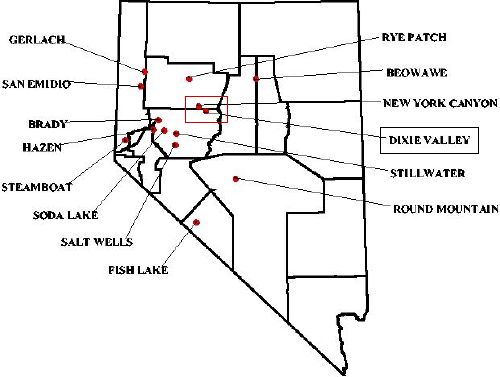
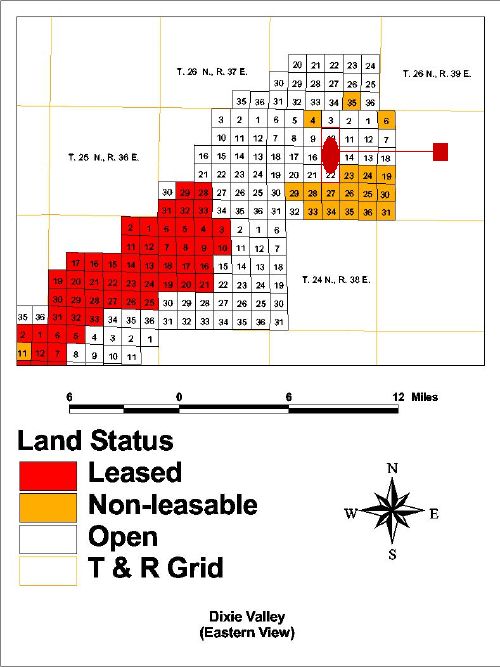
As with any geothermal prospect, exploration is paramount. Before the end of the year, MeV plans to complete aerial, self-potential, soil chemical, and magnetic surveys of the prospect. In addition, MeV plans a 2m shallow temperature survey with at least 100 measurement points (which can and will be adjusted in the field to accommodate the localization of any anomolies.) After collecting and analyzing this data, MeV may drill temperature gradient wells in locations suggested by the analysis of the prior surveys.
In addition to geothermal resource, MeV also observes that this location lies in the desert and is the recipient of copious amounts of sunshine year around. Given that benefit, solar surveys to characterize resource applicability for solar thermal electricity production will also be performed. Finally, there may be wind resource in the area and as such a wind resource analysis will be performed. This will help determine the feasibility of a “double” or “triple” play allowing multi-dimensional harvest of renewable resource below the surface level with geothermal, at surface level with solar thermal, and above surface level with wind all on the same physical property.
(Sou Hills Prospect in Rectangle Area >5 kwh/m2)
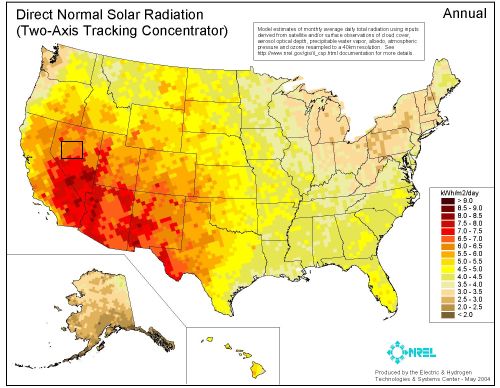
(Sou Hills Prospect in Rectangular Area – Detail in cutout below)
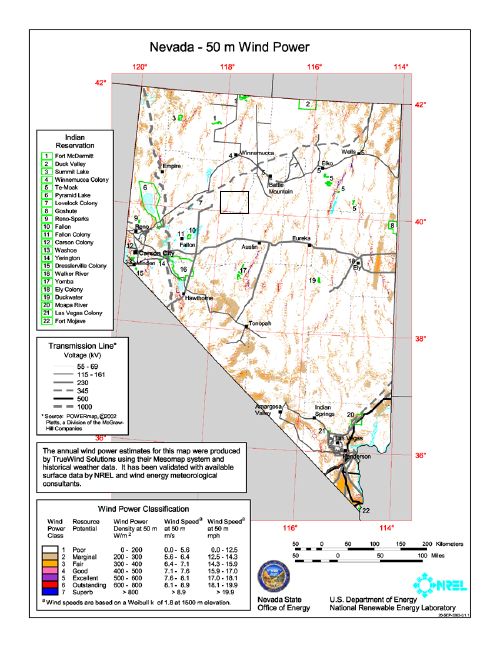
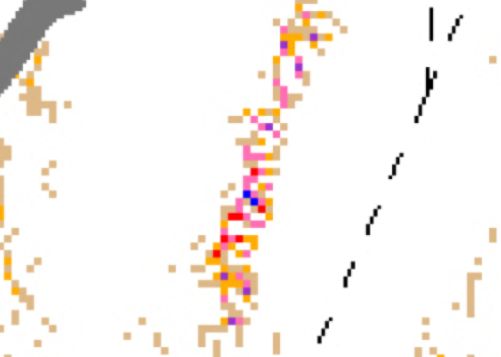
In concert, the wind, solar, and geothermal resources can share the same operations and transmission infrastructure. Solar thermal and geothermal can share the same physical generation resources. As solar resources become unavailable (darkness) wind resources in this area tend to increase and peak during night time hours. Of course, geothermal resources are not subject to sunlight and wind conditions and provide a constant baseload power output from the renewable energy park. Presently, the size and feasibility of this approach are unknown and will not be known until the resource assessment has been completed. However, the conditions are right for this approach to work in this specific property and perhaps others located around the world.
As results of resource surveys become available, we will share those results and the progress of our project in general. Comments are off for this post
Steamboat Springs Geothermal Plant
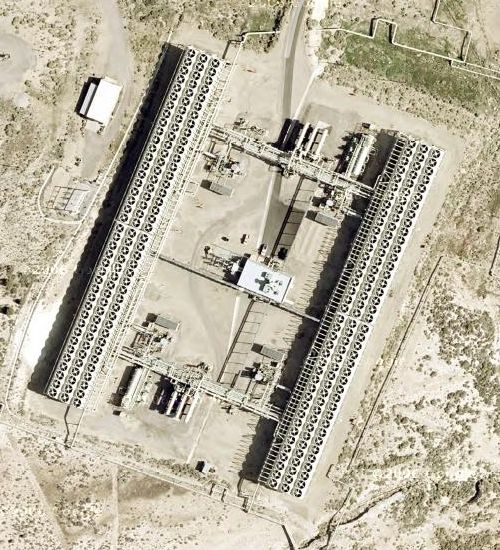
Last week on the way home from the GRC annual meeting, we decided to take a side trip that would take us by the Lower Steamboat Springs Geothermal plant operated by Ormat. The view above is courtesy of Google Maps, the view below was snapped from US 395 about 10 miles south of Reno, Nevada. The entire Steamboat Springs complex (4 plants, Upper and Lower Steamboat Springs) has a nameplate capacity of just over 64 MW.
